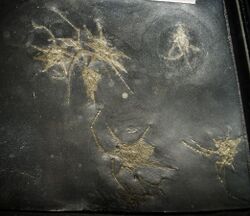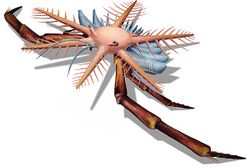Biology:Mimetaster
| Mimetaster | |
|---|---|

| |
| Fossil specimens | |

| |
| Life restoration | |
| Scientific classification | |
| Domain: | Eukaryota |
| Kingdom: | Animalia |
| Phylum: | Arthropoda |
| Class: | †Marrellomorpha |
| Order: | †Marrellida |
| Family: | †Mimetasteridae |
| Genus: | †Mimetaster Gürich, 1932 |
| Type species | |
| Mimetaster hexagonalis Gürich 1931
| |
| Species | |
| |
Mimetaster is an extinct genus of marrellomorph arthropod. The type species, Mimetaster hexagonalis is known from the Lower Devonian (Pragian-Emsian) Hunsrück Slate, and amongst the most common arthropods from the locality, with over 120 specimens including three juveniles.[1]
Description
The head shield of M. hexagonalis is oval shaped and raised on its upper surface, with three pairs of elongate straight projections radiating outwards, which have pairs of spines. On the upper surface was attached pair of probable eyes on segmented stalks. Attached on the underside was a pair of forward-projecting elongate segmented antennae, the first 10 segments of which were elongate, while the subsequent 14 were short and flagella-like, as well as two pairs of large uniramous leg-like appendages. The first of the two pairs was substantially larger than the second. Also present on the underside of the head was a hypostome, as well as a "ventral organ" of unclear function. The trunk consisted of up to 32 short segments, each of which except the last bore a pair of biramous appendages, which gradually decreased in size posteriorly. The endopods of the biramous appendages had 7 segments/podomeres, each with endites at the end of each segment except the last. The exopod had up to 40 segments, each of which had an individual seta projecting downwards.[1][2]
Ecology
M. hexagonalis probably lived in small groups on the seafloor,[1] walking in a tilted, upright posture propped up on its two uniramous legs.[2] The first six trunk endopods are much larger than the remaining pairs, and were likely also used in locomotion, albeit with less power than the two main legs.[1] They are thought to have been deposit feeders.[2] Many specimens have been found associated with tentaculitoids and sponge remains, which suggests that these taxa grew on the surface of Mimetaster as epibionts, which likely acted as camouflage.[1]
"Mimetaster" florestaensis
"Mimetaster" florestaensis is only known from a head shield, which is characterized by three pairs of curved principal spines, as well as strong secondary spines in the proximal two-thirds of the anterolateral spines. It was found in the Lower Ordovician (Tremadocian) Floresta Formation of Argentina, the first occurrence of this group in South America.[3] However the taxon is quite different from the type species, and was found in a phylogenetic analysis to be more closely related to Furca, and thus probably warrants being placed in a new genus, with the genus Tomlinsonus being the closest known relative of M. hexagonalis.[4]
See also
- Hunsrück Slate
References
- ↑ 1.0 1.1 1.2 1.3 1.4 Kühl, G.; Rust, J. (2010). "Re-investigation of Mimetaster hexagonalis: a marrellomorph arthropod from the Lower Devonian Hunsrück Slate (Germany)". Paläontologische Zeitschrift 84 (3): 397–411. doi:10.1007/s12542-009-0049-x.
- ↑ 2.0 2.1 2.2 Wilhelm, Stürmer Erlangen; Lund, Jan Bergström (June 1976). "The arthropods Mimetaster and Vachonisia from the Devonian Hunsrück Shale" (in en). Paläontologische Zeitschrift 50 (1–2): 78–111. doi:10.1007/BF03001974. ISSN 0031-0220. http://link.springer.com/10.1007/BF03001974.
- ↑ Aris, Maria; Corronca, Jose; Quinteros, Sebastián; Pardo, Paolo (2017). "A new marrellomorph euarthropod from the Early Ordovician of Argentina". Acta Palaeontologica Polonica 62. doi:10.4202/app.00240.2016. ISSN 0567-7920. http://dx.doi.org/10.4202/app.00240.2016.
- ↑ Moysiuk, Joseph; Izquierdo-López, Alejandro; Kampouris, George E.; Caron, Jean-Bernard (July 2022). "A new marrellomorph arthropod from southern Ontario: a rare case of soft-tissue preservation on a Late Ordovician open marine shelf" (in en). Journal of Paleontology 96 (4): 859–874. doi:10.1017/jpa.2022.11. ISSN 0022-3360. https://www.cambridge.org/core/product/identifier/S0022336022000117/type/journal_article.
Wikidata ☰ Q19911385 entry
 |



